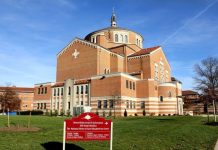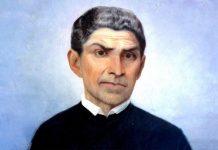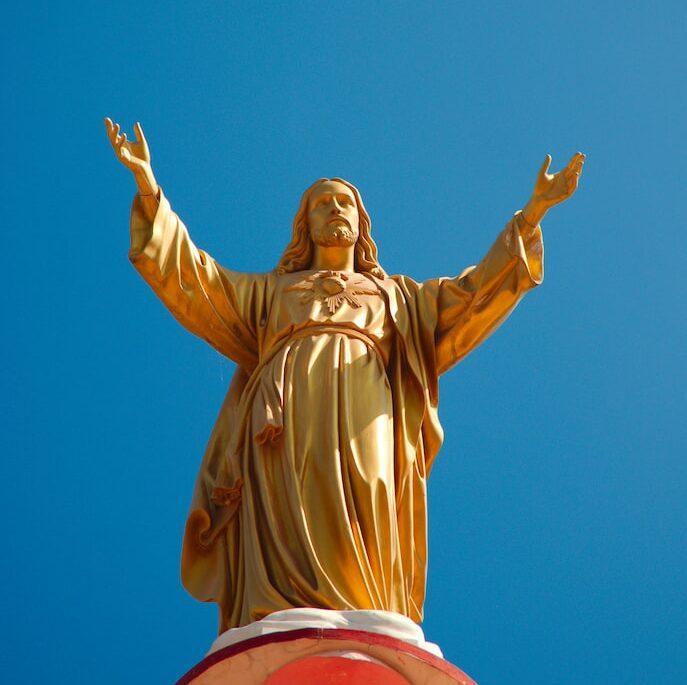St Claude de La Colombière … Confessor and confidant of Saint Margaret Mary Alacoque, he was chosen by God to spread love and trust through devotion to the Sacred Heart of Jesus.
Newdesk (21/02/2023 11:05 AM, Gaudium Press) Little is known of the childhood of the priest of La Colombière. He was born on February 2nd, 1641 in the village of Saint-Symphorien, but at the age of nine he moved with his family to Vienne, where the Benedictines of Saint Andres-le-Bas sowed in his soul the first seeds of his ardent devotion to the Holy Eucharist and administered his First Holy Communion.
When he was seventeen, Claude decided to become a Jesuit. He was reserved in temperament, a little shy and very affectionate. But he did it willingly and completely, understanding that true happiness consists in giving oneself to God through an exclusive love.
Later he would say: “Jesus Christ promised me a hundredfold, and I can say that I have never done anything without receiving, not a hundredfold, but a thousand times more than I had given up.”
From the novitiate to the priesthood
It was the year 1658 when Claude entered the novitiate of Avignon. There he alternated between trials and joys, periods of aridity and others marked by an overflowing light. Two years later he took his first vows and, having finished his course in philosophy, he dedicated himself to teaching in the college of the Society, as the rules determined, before continuing his studies for the priesthood.
His academic merit and the example of his religious life earned him the position of tutor to the children of Colbert, Louis XIV’s famous Minister of the Treasury. He had to frequent the ambiance of the court, making many friends there and showing great talent, refined manners and an excellent education, as well as being outstanding for his firmness of principles and deep virtue.
The Third Trial
On April 6, 1669, Claude received holy orders and five years later came for him the time called by St. Ignatius as the “School of Affection”.
The House of St. Joseph in Lyon was the place where Father Claude went through this period, during which he made a particular vow of exact observance of the rules of the Institute “without reserve”, disposing himself to accept with joy the determinations of Holy Obedience and to break once and for all the chains of self-love.
At the same time, he consolidated in his soul his trust – also without reserve – in the Divine Mercy, without which it would have been impossible for him to remain faithful to the resolutions he had made for his own sanctification and that of others.
This time of solitude and recollection also made him detach himself from all human relationships, to which he was extremely sensitive, in order to have Our Lord as his only and true friend.
Before he had even completed the time required, he was admitted to solemn vows, which he made on his 34th birthday, February 2nd, 1675.
Shortly afterwards, he was appointed superior of the Jesuit house in Paray-le-Monial. His soul had the ideal temperament to undertake the great mission that awaited him.
Three hearts united forever
Father de La Colombière did not know what he would find in this small town, but his superiors, learning of the visions of St. Margaret Mary Alacoque and the controversy that they had generated, chose him precisely because of his equilibrium of soul.
In fact, without caring about the criticism and unfavourable judgements, he soon saw the hand of God in the visions of Sister Margaret Mary and reassured and supported her, receiving, as a reward, messages and favours from the Divine Master.
One of these occurred once, during the Mass celebrated for the community, when the nun saw, at the hour of Communion, the Sacred Heart of Jesus like a burning furnace and two other hearts engulfed in Him: that of the priest of La Colombière and her own, while she heard these words: “It is thus that my pure love unites these three hearts for ever. This union is for the glory of my Sacred Heart. I want you to discover its treasures; it will make known their price and usefulness. To this end, be like brother and sister, sharing equally in the spiritual goods“.
Apostolate of trust
In the short eighteen months of his stay in Paray-le-Monial, Fr. de la Colombière probably did more for souls than in all the previous years of his life.
Jansenism, then at its height in France, was undermining in hearts the confidence in the goodness of Our Lord and of his Blessed Mother, and turning the faithful away from the Sacraments, especially from Holy Communion.
The apostolate carried out by St. Claude in his letters, preaching and spiritual direction went precisely in the opposite direction: it promoted confidence in Mary and devotion to the Blessed Sacrament. He thus attracted many straying sheep, bringing them back to the fold of the Saviour.
He founded a Marian Congregation for noblemen and burghers, in which he gathered together the Catholic gentlemen of the city, as well as reorganizing that of the students of the Society’s college. He restructured the hospital for pilgrims and the needy, and preached missions in the neighbouring towns, with great fruits of reaffirmation.
“Behold the Heart that loved men so much”
But his greatest mission was to participate, by design of Jesus himself, in the so-called “Great Revelation” made to St. Margaret Mary, on a day in the Octave of Corpus Christi in 1675, while she was praying before the Blessed Sacrament: the spread of devotion to the Sacred Heart of Jesus, as well as the institution of its feast and of the reparatory consecration.
The saint transcribed the famous words of Our Lord as He showed her His Divine Heart: “Behold the Heart that loved man so much that It spared nothing to the point of exhausting and consuming Itself to manifest Its love. And in recognition of this I receive from most of them nothing but the ingratitude, contempt, irreverence, sacrilege and coldness that they have towards Me in this Sacrament of Love. And it is all the more repulsive because they are hearts consecrated to Me.”
The Lord then asked that the first Friday after the Octave of Corpus Christi be consecrated as a special feast to honour His Heart, with a public act of reparation and reparatory communions. He added a formal promise to grant copious spiritual favours to whoever practised such devotion.
The nun alleged her unworthiness and inability to carry out the mission, and received this reply: “Go to my servant Claude and tell him, on my part, to do everything possible to establish this devotion and to give this pleasure to My Divine Heart; that he not be discouraged in the face of the difficulties he will encounter, for these will not be lacking, but he must know that he is all powerful who distrusts himself to trust in Me alone”.
Thus, on the following Friday, St. Claude, St. Margaret and the community of the Visitation of Paray-le-Monial celebrated, for the first time, the Feast of the Sacred Heart of Jesus, consecrating themselves entirely to Him.
Mission to the Duchess of York
When he was at the height of his activities in Paray-le-Monial, Father de La Colombière was ordered to leave for London, as chaplain to the Duchess of York, Mary of Modena, who was a fervent Catholic and had only consented to marry the Duke, brother of Charles II, after being permitted by the English government to have a priest always with her.
Through the holy seer, the Heart of Jesus recommended to St. Claude some attitudes to be observed in his new mission: not to be frightened by the onslaught of hell against his charisma to attract souls, but to trust entirely in the goodness of God, for He would be his support; to use gentleness and compassion towards sinners; to be careful never to separate good from its source.
His departure was very painful for St. Margaret, which earned her a reproach from Our Lord: “Am I not enough for you, who am your beginning and your end?”
As chaplain to the Duchess of York, he lived in the palace of Saint James, but he did so in a regime of deep recollection and great mortifications. He was concerned only with spreading devotion to the Holy Eucharist and the Sacred Heart of Jesus, despite the difficulties created by hostility towards the Church.
He ended, however, by converting whole families and attracting to the consecrated life many members of the London aristocracy. Some of these he directed to religious institutions in France; others he brought together in London itself, in a clandestine monastery that he founded near St. Paul’s Cathedral.
It was about this time that Titus Oates unjustly accused the Jesuits and other members of the Church of plotting the assassination of Charles II, in order to replace him with his brother, the Duke of York, who had converted to Catholicism.
Although the king himself considered this accusation absurd, it gave rise to violent persecutions of Catholics unjustly accused of having taken part in the so-called “Papist plot”.
On the pretext of these events, St. Claude was denounced and imprisoned for the crime of religious proselytism. The terrible conditions of the prison where he was thrown ended up undermining his health, already weakened by an incipient tuberculosis. He would have died there in a short time, had he not been freed through the intervention of Louis XIV.
End of the Holocaust
He arrived back in France in mid-1679, almost without strength. After regaining a little health, he went to the College of the Holy Trinity in Lyon. There, although physically very exhausted, he did not cease to propagate devotion to the Divine Heart, defending It against the innumerable attacks and misunderstandings to which It was subjected.
In the winter of 1681, he returned to Paray-le-Monial, where the climate seemed to be a little more beneficial. But in view of the intense cold of that harsh season, they thought of transferring him to Vienne, where he would be looked after by his brother, the archdeacon of that diocese. But the superior of the house ordered him to stay, after St. Claude had received a note from St. Margaret, with this message from his Divine Friend: “He told me that He wants the sacrifice of his life here.”
The holocaust was not long in being consummated. On February 15th, 1682, at the age of only 41, Claude de La Colombière went to meet the One whose faithful servant and perfect friend he had been on this earth. A few hours after the funeral, Sister Margaret, whose heart remained united to his in the Sacred Heart of Jesus, was able to make this recommendation: “Stop worrying now; call upon him with all confidence because he can help us”.
However, the great mission of St. Claude was not to be fully realized until many years later, on May 8th, 1928, when Pius XI raised the Solemnity of the Sacred Heart of Jesus to the supreme liturgical category with the Encyclical Miserentissimus Redemptor.
A year later Claude de la Colombière would be beatified by the same Pope. And it fell to John Paul II, on May 31, 1992, the honour of including in the catalogue of saints the name of this Jesuit priest so loved by the Divine Heart of Jesus.
Text extracted, with adaptations, from the magazine Heralds of the Gospel, n.110, February 2011.
Compiled by Roberta MacEwan



































